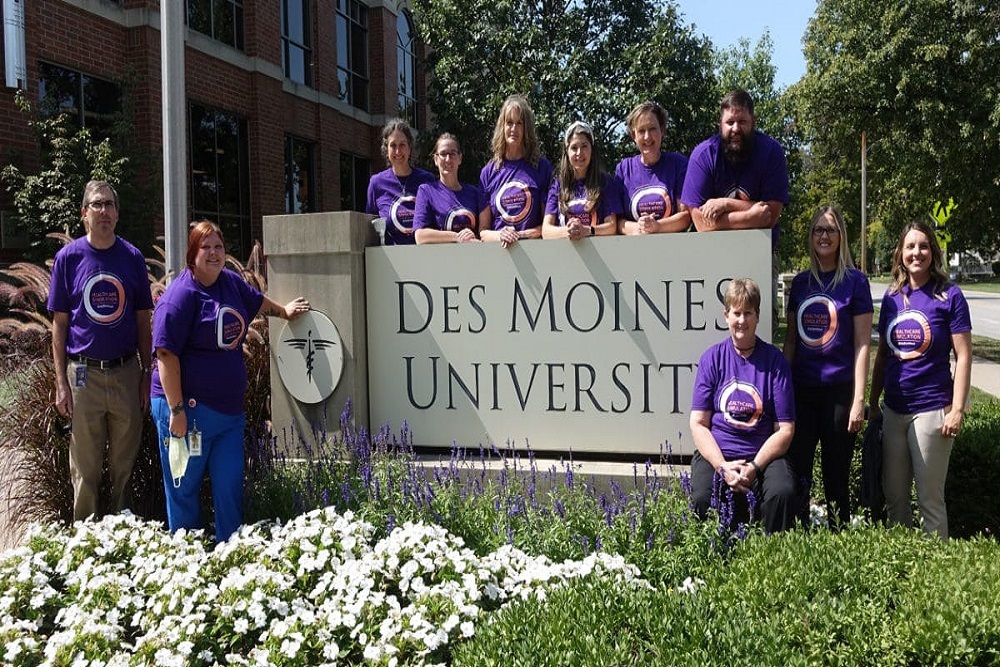Des Moines University recently issued the following announcement on September 13.
The health care provider students are gathered around the patient, who came into the emergency room complaining of heartburn and chest discomfort. They are beginning to feel anxious because the patient said her discomfort is becoming worse, and she now has pain in her jaw and right arm. Nervous and a bit overwhelmed, the students turn to their classmates. They are in this together, and they all want the same outcome – a healthy patient.
They call a huddle to discuss the patient’s signs and symptoms and determine differential diagnoses and orders. The team lead delegates orders, and they work together to care for their patient. With lab results and 12-lead ECG results in, they confirm their diagnosis and hand off care to the cardiology team.
The students leave the emergency room and sit down together to reflect and debrief. Next time they see these signs and symptoms, they’ll be ready to act faster and feel more prepared to work with the care team.
Next time, this scenario will be with a real patient in a real emergency room.
In this case, the emergency room is in the lower level of Ryan Hall, part of DMU’s Iowa Simulation Center, and the patient is a high-fidelity medical mannequin. The students are aspiring health care providers in DMU’s four clinical programs – osteopathic medicine, podiatric medicine and surgery, physician assistant studies and physical therapy.
Every year, the Simulation Center facilitates more than 600 events – 2,000 event hours – for more than 10,000 learners. To increase awareness about the importance of simulation in health care education and celebrate the roles of simulation professionals, the Society for Simulation in Healthcare (SSH) is sponsoring Healthcare Simulation Week Sept. 13-19.
“Health care simulation has many proven clinical impacts, including improving patient outcomes, reducing medication errors and improving teamwork,” says Kimberly Patterson, M.S.N., R.N., CHSE, director of the DMU Simulation Center. “It allows students to practice and make mistakes in a safe environment, ultimately preparing them to provide better care to real patients.”
According to SSH, simulation is the imitation or representation of one act or system by another. In health care education, the simulation of a wide variety of scenarios – from giving an injection to caring for a “patient” in an emergency room – bridges classroom learning and real-life clinical experience. Ultimately, simulations improve the safety, effectiveness and efficiency of health care services, because they enhance the skills of the people providing them.
It takes a great team to provide students with invaluable simulation experiences (from left): Mike McLaughlin, Ph.D., Simulation Laboratory manager; Cheyanne Courtney, simulation specialist; Melinda Carriker, human simulation educator; Teresa Rader, clinical coordinator, simulation; Shelley Oren, instructor/Basic Life Support coordinator; Diana Altamirano, CHSE, simulation specialist; Brenda Scovel, Surgical Skills Lab coordinator; Joe Case, simulation technical specialist; Barb Klocke, CHSOS, simulation specialist; Ashley Kern, administrative assistant; and Kimberly Patterson, M.S.N., R.N., CHSE, Simulation Center director.
“Health care simulation continues to grow at an extraordinary rate,” says SSH Past President Bob Armstrong. “An increasing number of professionals in the healthcare industry are waking up to simulation’s ability to help individuals and organizations improve patient care, which is so great to witness. We want to celebrate both that increased role and all healthcare simulation professionals this week.”
At DMU, simulation encompasses the Simulation Laboratory, Surgery Skills Lab, Basic Life Support Lab and the Human Simulation Lab. In these labs, students use a variety of tools in different settings to practice their skills. Those tools and settings are determined by the objectives of their courses and the best modalities to help students achieve them.
“Planning a simulation is a little like planning a stage show. There’s a lot that goes on behind the scenes,” Patterson says. “We work with faculty to consider all the tools in our toolbox and choose the best ones to meet course objectives.”
In the Simulation Laboratory, cases are presented via high-fidelity medical mannequins that exhibit human physiologic functions such as blood pressure, reactive pupils, working tear ducts and heart and lung sounds. As teams of students question these “patients,” diagnose their conditions and administer treatment, the mannequins’ conditions and responses are controlled by staff in adjacent rooms who observe students through a one-way mirror. After each session, students debrief with supervising clinical faculty. The experiences are designed to develop students’ clinical reasoning skills, communication, leadership and interprofessional teamwork.
Students also work with the University’s Lifecast mannequins, which are highly lifelike in appearance and skin texture. DMU uses Lifecast models of different ethnicities, skin tones and ages, better preparing students to provide care to an increasingly diverse patient population.
“The Lifecast models are Hollywood meets simulation,” Patterson says. “That they are so lifelike changes students’ reactions to them. For example, when students are handed the infant model, often they immediately start rocking it.”
In the Human Simulation Lab, students interact with individuals who are trained to portray real patients. The lab’s 12 exam rooms are equipped with audio/video cameras and one-way glass to enable clinical staff to observe students as they interact with the patients, perform non-invasive physical exam techniques and make diagnoses. After the sessions, which are videotaped, students receive feedback from staff and their “patient.”
In the Surgery Skills Lab, students practice techniques ranging from knot-tying and performing tracheotomies to inserting catheters and IVs. The lab’s two large simulated operating rooms feature multiple stations and scrub sinks so students can learn and practice skills such as scrubbing into surgery and properly donning medical gowns, gloves and masks.
“When students are on rotations and know correct sterile techniques, that makes it so much easier for emergency room or operating room staff,” Patterson says. “It makes our students stand out in terms of their skills.”
She is excited about new technologies in simulation, including virtual reality, telehealth technology and the use of virtual patient simulators. When DMU moves to its new campus in West Des Moines, it will use a $2 million CARES Act Recovery Assistance grant from the U.S. Economic Development Administration to acquire the latest telehealth technology and equipment that will be part of its new state-of-the-art simulation center.
“That will give us more tools to teach students,” Patterson says.
Original source can be found here.



 Alerts Sign-up
Alerts Sign-up